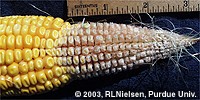

![]() ne of the more common complaints overheard in recent
days downtown at the Uptown Bar & Grill has to do with ears of corn that
have not filled all the way out to the tip. Folks walking their fields scouting
for stalk rot have also discovered ears with one to two inch barren tips.
ne of the more common complaints overheard in recent
days downtown at the Uptown Bar & Grill has to do with ears of corn that
have not filled all the way out to the tip. Folks walking their fields scouting
for stalk rot have also discovered ears with one to two inch barren tips.
 What are some of the causes
of tip fill problems in corn and what are the yield consequences?
What are some of the causes
of tip fill problems in corn and what are the yield consequences?
Barren tips of cobs result from some combination of an absence of kernel development and shriveled, aborted kernels. Each has a different set of possible causes.
An absence of kernel development indicates that pollination itself was not successful. The list of possible causes includes severe silk clipping by insects (corn rootworm or Japanese beetles) during the final stages of pollination, delayed silk emergence or deterioration of exposed silks due to excessive heat or drought conditions, silk emergence failure due to silkballing near the tip of ear, and lack of viable pollen due to excessive heat or drought conditions. Diagnosing the exact cause later in the grain fill period can be challenging.
The occurrence of kernel abortion signals the incidence of severe photosynthetic stress during the first few weeks of grain fill following the end of pollination. Tip kernels are especially vulnerable to abortion because they are the result of the final days of pollination and therefore are technically the youngest kernels on the ear and most sensitive to subsequent severe photosynthetic stress.
Factors that can severely limit photosynthesis include consecutive cloudy days, excessive heat and drought conditions (especially when accompanied by severely compromised root systems), and loss of significant leaf area due to hail damage, severe nutrient deficiencies (think nitrogen this year), severe leaf diseases (e.g., gray leaf spot or northern corn leaf blight), and insect feeding injury (e.g., grasshoppers). There is anecdotal and some research evidence that unusually warm nights (mid-70’s or warmer) during early grain fill periods may also contribute to abortion of tip kernels.
Ear size potential can influence the occurrence of barren tips. Remember that potential ear size (number of ovules) is determined early in the development of the plant, from approximately V6 (six visible leaf collars) to V15. Favorable growing conditions during this period encourages large ear size potential, especially in terms of ovule number per row (ear length).
Lengthy potential ears heading into pollination obviously maximize the potential kernel set and grain yield. Sometimes, though, unusually lengthy ear size results in barren tips if the final tip silks emerge after the field’s pollen shed is already complete and thus never receive pollen. If pollen is available to pollinate the late emerging tip silks of lengthy ears, the resulting kernels are often dramatically “younger” than the remainder of the kernels on the cob and, therefore, particularly sensitive to severe photosynthetic stress.
Obviously, absent kernels translate to lost yield potential. Mathematically, for every absent kernel per row on an 18-row corn hybrid (assuming a final ear count of 28,000 ears per acre), the lost yield potential equals about 6 bushels per acre. Yes, yield loss can mount quickly as a consequence of barren tips.
But, it is also important to make sure you put the problem into perspective. Before you complain about barren tips to your seed rep, first evaluate the remainder of the cob. Typical kernel count for harvested ears of many hybrids is approximately 600. Hybrids whose ears are typically 16 rows in girth tend to set about 36 - 40 kernels on each row, while those that typically develop 20 rows of kernels tend to set closer to 30 kernels per row.
The point here is that if potential ear size (number of ovules) was quite large heading into pollination (favorable pre-pollination conditions) but failed to pollinate the tip silks, the resulting ears may still exhibit 30 – 40 kernels per row even though there is one to two inches of barren tip. In other words, harvested ear size will still average about 600 kernels and ultimate grain yield will be average to above average.
On the other hand, if kernel counts show only 20 to 25 kernels per row with lengthy barren cob tips, then that indeed indicates that the crop suffered significant stress conditions probably more than once during the season. Kernel counts per ear will be much less than 600 and ultimate grain yield in this latter example will likely be less than average for that field and/or hybrid.


Nielsen, R.L. (Bob). 2002a. When and How Can I Estimate Corn Yields. Purdue Univ. Corny News Network. Available online at http://www.kingcorn.org/news/articles.02/Yld_Est-0723.html. [URL verified 9/17/03].
Nielsen, R.L. (Bob). 2002b. Yield Loss During Grain Fill. Purdue Univ. Corny News Network. Available online at http://www.kingcorn.org/news/articles.02/Grainfill_Stress-0802.html. [URL verified 9/17/03].